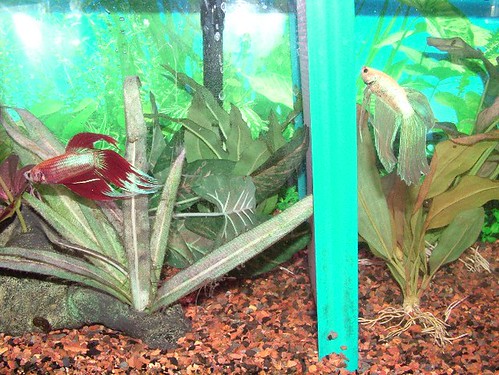Q: NB wrote,
I’m setting up a divided 10 gal for my two males. I have a store bought mesh tank divider, which should work fine but I’m afraid the filter is only going to clean one side of the tank. The holes in the mesh are so small I don’t see how it’s going to work for the other side. Is this going to be a problem?
A: You’re right that there won’t be equal filtration in your 10 gallon [37.8 L] with the standard plastic mesh dividers and a “hang on back” (HOB) filter on only one side. The filter may circulate all the water, filtering fine particulates but larger pieces just aren’t going to get through. Over time, one side of the aquarium will end up with fish waste and debris levels higher then the other side.
The first and easiest thing you can do is to vacuum the substrate on both sides of tank using a basic aquarium siphon. This will remove the large particles and can be done at each water change or every other if your water parameters are good. You may, however, notice that there is a strong current on one side of the tank and virtually none on the other. To avoid very strong currents on one side, I suggest purchasing an HOB filter with an adjustable intake valve. This will help to reduce added stress caused by the current. If there is no surface agitation on the other side, you may notice a protein layer coating the water’s surface within a few days of a water change. It’ll look like a foggy grey or white coating sitting on top of the water. It isn’t generally harmful but is rather unsightly.
To get more even distribution, many aquarists opt to have two smaller HOB filters in their tank; one on either side. Again, these work best when they have an adjustable flow control. Because there are two, you can buy smaller filters that circulate half the GPH. I know that Whisper Power Filters often come with adjustable flow control and are available in smaller sizes. They work well in most aquarium set-ups and are the best option if you are using a fine substrate like sand.
If you have gravel on the bottom of your aquarium or another larger particulate substrate, an undergravel filter (UGF) may be a viable option for you. UGFs mainly consist of a slotted plastic plate that sits on the bottom of your aquarium under the substrate. When powered with an air pump, they have very little current but still filter out the debris. Cleaning them is a little more challenging then it is for an HOB filter but the upside is that they take up much less swimming space and are visually more appealing, which can be a real asset in a small 10 gal aquarium. Because the waste material needs to be filtered through the slots, UGFs are not appropriate for aquariums with a sandy bottom. Because they sit on the tank bottom under the dividers, they won’t interfere with your division system and will filter both sides pretty evenly.

I have two divided 10-gal tanks and have Azoo Palm filters (small and quiet, for 5 gal tanks with adjustable output) on either side of the divider. So far it’s working really well! Bettas and ADFs are happy, tank is nicely cycled. If only I could combat the algae…